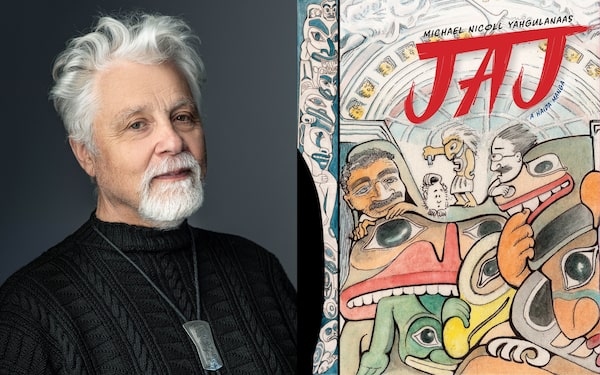
Michael Nicoll Yahgulanaas, author of JAJ: A Haida Manga, and the cover of the book.Karolina Turek/The Canadian Press
On a ship with torn sails, tossed by churning waters, the first of many Europeans needing rescue arrives along the coast of what is now British Columbia, before a Haida canoe brings an outstretched paddle and the warm light of salvation.
So begins the latest book of Haida Manga by artist and author Michael Nicoll Yahgulanaas, as he reaches into the history of his own family and of colonization in a work that blends Indigenous artistic influences with Japanese manga comic-book story telling.
The colourful watercolour panels of JAJ: a Haida Manga leap off the page as they draw the audience inside the world-spanning story.
Released in May, the book traces the journeys of both Mr. Yahgulanaas’s ancestors and the eponymous Norwegian mariner Johan Adrian Jacobsen, who visited Haida Gwaii in 1882 in search of cultural items for a German museum during a time of escalating colonial violence against Indigenous Peoples.
Mr. Yahgulanaas – whose works are in institutions including the British Museum, Metropolitan Museum of Art and Vancouver Art Gallery – said the story represents an invitation to humanize each other and forge a path toward a better future.
He said he found himself empathizing with Jacobsen, a young man who was “promised much and given little” by those who hired him.
“I discovered that, like myself, he comes from a small fishing village. His family would harvest seabird eggs for sale and eating, and I’ve done the same,” he said.
The artist’s mission is to create artwork that “allows people who don’t know us to see us as humans,” which he said hasn’t been the case for Indigenous Peoples and people of colour through colonization, and to a significant degree still isn’t.
“I thought, if people could see the ‘other,’ whoever the other is, as a son or a daughter, that would go a long way to humanizing and alleviating the violence.”
The panel style of JAJ is common to Japanese Manga and graphic novels, but instead of rigid boxes, Mr. Yahgulanaas’s story inhabits windowlike spaces opened by a sinuous black line ebbing and flowing through the pages.
Unfold the dust cover and a surprise is revealed – the book’s 108 pages combine to form a single mural. The black line delineating the panels expands and contracts symmetrically across the mural, forming the image of a creature that recalls an old Haida weaving design.
It’s a style Mr. Yahgulanaas has employed in previous Haida Manga works.
The original JAJ mural, four metres in length, now hangs in the Humboldt Forum, a museum in Berlin whose representatives approached Mr. Yahgulanaas to see if he was interested in creating a piece of artwork reflecting on Jacobsen’s story.
Also on display at the German museum is the Haida totem pole that Jacobsen brought back with him.
Mr. Yahgulanaas’s work is at once playful, mischievous and serious; he depicts an encounter between Jacobson and one of his real-life ancestors, George, as a key part of the narrative.
Some encounters like this are imagined, but real historical figures play an active role in the story, overseeing the spread of smallpox that devastated Indigenous communities.
While doing research for JAJ, Mr. Yahgulanaas said he discovered that ancestors on his father’s side came from the same part of Norway as Jacobsen, making the story even more personal.
“It became more important to humanize all the characters,” Mr. Yahgulanaas said.
Jacobsen went to Berlin to try to establish a career, improve his circumstances and start a family, and Mr. Yahgulanaas said he moved to Vancouver with similar desires.
Mr. Yahgulanaas comes from Masset, on the northern tip of Haida Gwaii, where artwork has long been an economic driver.
He said that artwork has tended toward the “monumental,” often ending up in privileged places like grand institutions and private collections.
That bothered Mr. Yahgulanaas.
“We reduce ourselves as individuals. We make ourselves small in the presence of that which is grand and great,” he said.
The scale of Mr. Yahgulanaas’s murals preserves a sense of grandeur, but transforming them into books makes them accessible and engaging.
“A book can live in your hand. You can flip the page forwards and backward. You are in control of the flow of the story … it is subject to your interpretation.”
Comic books and graphic storytelling can also span barriers of ethnicity, class, language and education, Mr. Yahgulanaas said.
The artist said JAJ is an invitation to start a conversation, and forge new relationships that put an end to violence.
“It’s the Haida belief that if you make friends first, if you establish the human relationship first, then those difficult questions can be resolved much easier.”